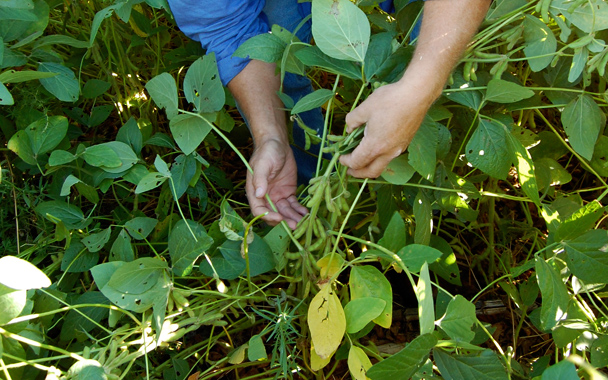Don’t let the huge machinery fool you. Family farming is one of the last bastions of manual labor in America. As I have grown closer to four South Dakota farmers this summer, it is apparent that accumulating wealth does not translate into distance from the land and work. In harvest season, retired fathers and grandfathers are the first to the tractors and the first to the shovels. It’s in their bones. So it is agonizing for farmers to sit around and wait ... especially at the feet of Mother Nature. And yet, this week our four farmers are waiting out the rain, waiting for muddy fields to dry. Talk turns to soybean “pod busting,” the profit-sucking, end-of-season process in which moist beans continue to grow and swell inside pods that have dried and died. When the pods crack open, beans fall onto the ground and are lost. “We could lose as much as a bushel an acre,” reports Dale Hargens. One more thing to obsess about, but no reason to wait around doing nothing.
Dale has decided to change the soybean head on his combine to corn and make a preliminary pass around the edges of his cornfield, “just to check the yield and the moisture content of the corn.” He knows he’s got the mother lode out there and he would like some real numbers to talk about. Jim Lutter is on top of a ladder finishing the roof of his hunters’ cabin. Pheasant season opens in a few days, guests will begin arriving, and he might as well keep busy. Charlie Johnson is cultivating a new alfalfa field. Anything to keep from thinking about the prospect of low soybean yields and collapsing commodity prices.
My attention turned this week to Michael Pollan’s powerful, forward-thinking “open letter” to the next “farmer in chief” in The New York Times Magazine. Pollan is the best-selling voice of a growing food movement in America, and it seemed like fertile ground to compare his policy prescriptions for the next president with the day-to-day lives of four South Dakota farmers. The starting point: None of our four farmers has ever heard of Michael Pollan, and they do not read The New York Times. The gap is enormous.
Pollan’s core premise, that the nation should move from a fossil-fuel-based food economy to solar-based, ecologically holistic farming, is dumbfounding to conventional farmers who are totally dependent on fossil fuel inputs. These are families who have been encouraged by government policy and technical advisors to embrace the industrial model of farming for so many decades that there is no countervailing, experience-based, local knowledge of how natural systems work. And the consequences of day-to-day choices are often overwhelming. For example, in the abstract these farmers can appreciate the idea of integrated pest management on farms with diverse crops. But all the pressure of federal policy pushes them away from diversity. And there is nothing more terrifying than to wake up and find not three or five or ten aphids chewing away on a soybean or sunflower leaf, but hundreds, sometimes thousands ... on one leaf. That’s when they call Jim Lutter and ask him to spray.
Several times this summer my conversations have turned to organic farming, which is a fundamental value of Pollan’s national food policy. Three of the four farmers we’ve been following are nonorganic, and the shared experiences of Charlie Johnson, the one farmer who is organic, have done nothing to excite their curiosity. “Too much hard work,” Scott Christenson told me at the beginning of summer. I expected resistance because the economics of organic farming are difficult, especially on the northern Plains, where farmers operate at enormous scales and are so removed from urban markets. But the root of the resistance is deeper. These men think mainstream industrial farming is safe and healthy, and they think organic farming is dangerous. “I just don’t trust what they put on the land,” says Jim Lutter. He conflates the troubles with bacterial contamination in produce from Mexico and California with organic methods. Dale Hargens stands in the middle of his soybean field and tells me, “I think Roundup [the ubiquitous Monsanto herbicide that has revolutionized production on industrial farms] is so safe, you could eat it.”
In many ways this is a land of lost knowledge. How can it be changed? Farmers and citizens (and future presidents) interested in sustainable farms that produce healthy food would do well to look at the failures of America’s land-grant agricultural colleges, one of which, South Dakota State University, is within a morning’s drive of all four farmers. At SDSU, a student can major in a dozen different agricultural disciplines, but never have the opportunity to study the ecology of organic farming. Extension fieldwork sponsored by the university is quick to explore how the use of genetically modified seeds and aggressive no-till procedures increase yields, but is not much help to farmers who are interested in improving the biodiversity (and thereby the productivity) of their soil.
The waiting is also getting to me. Pheasant season opens on Saturday. Dale Hargens will be back in the soybeans on Monday. And soon, very soon, the dirt roads will be clogged with trucks piled high with corn.




 Pinterest
Pinterest


